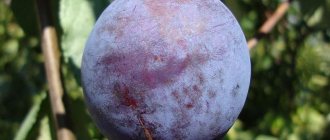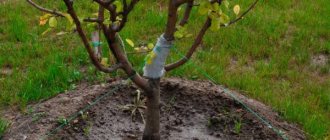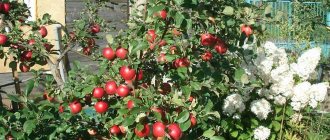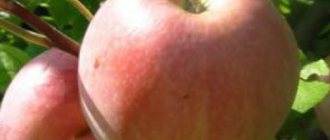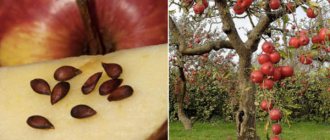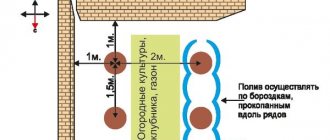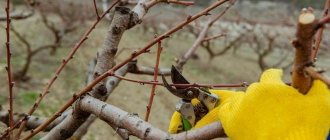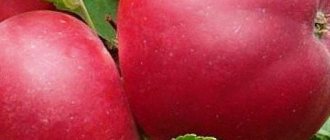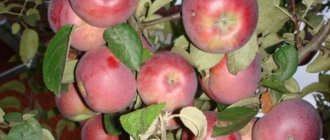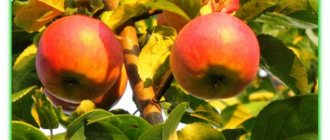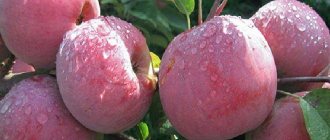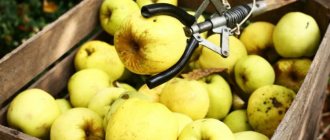» Gardening » Apple tree » Forest (Wild) apple tree - description of the variety
0
1145
Article rating
According to scientists, the forest apple tree originally grew in the warm climate of Western Asia. It served as an important source of vitamins for the inhabitants of Iran, Mesopotamia, Anatolia and neighboring regions. From the Persians it came to the Greeks, who made cider from the fruit. As the climate warms and forests shrink, it has spread across much of Europe.
- Vaccination rules
- For the bark
- Into the cleft
- Collection and storage of fruits
- Diseases and pests
- Recommendations for growing
- Let's sum it up
Apple tree Forest (Wild) - description of the variety
Places of origin of the wild apple tree
The wild apple tree grows in almost any place: coniferous or broad-leaved, on the roadside or in company at the edge of the forest. The plant feels comfortable in a sunny place, but the shade will negatively affect the amount of harvest.
Game is most common in Ukraine, Belarus and the European part of the Russian Federation. It is grown near roads as a hedge or shelterbelt. Not many people plant it on their own plot because they save precious space.
Features of the Lesnaya apple tree variety
Honey plants – Features of the Lesnaya apple tree variety
Features of the apple tree variety Lesnaya – Honey Plants
The apple is the fruit of seduction and temptation. Eve herself in the Gardens of Eden succumbed to the sweet words of the serpent and tasted the forbidden fruit. Adam also tasted it. If they could not resist, then how can modern gardeners overcome their attraction to this sweet, juicy fruit?
Characteristics of the wild apple tree
The well-known apple tree growing in the garden has the usual sweet or sweet and sour taste and light flesh. 90% of modern varieties of apple trees fall under this garden description. But among them there is one, the origin of which is not connected with the institutes of genetics and selection. This special variety is called Woodland Apple. Due to its origin from the flattering thicket, the common people usually call it “wildlife”. It has retained its original shape and wonderful forest taste. She is still the same wild apple tree as she was before, but now she can be found in the garden of a picky gardener.
A little geography
The apple tree is the first tree to appear in the improvised first gardens of mankind. Our ancestors first began to praise him, and numerous myths and legends testify to this. There are references to apple plantations in Egypt. Apple seeds have been found in mummies of ancient people.
Often such an apple tree can be found in European broad-leaved or mixed forests. But there are enough cases when it comes across in forests. This apple tree is wild not only in origin, but also in all its main components. Although the shape of its crown is neatly round and spherical. Often its branches can be prickly.
It is not very easy to meet such a tree, but it is possible. In most cases, these are solitary trees that can grow on forest edges, clearings, and the sides of forest paths. It can be found even in the mountains at altitudes of more than 1000 meters.
Characteristic four varieties
The forest apple tree is truly a long-liver, since uncultivated it can extend its life up to fifty years. It can be distinguished by its height and width. This large dimensional tree has the following “beauty” parameters:
- width - from 6 to 8 meters;
- height - from 8 to 10 meters.
The root system is superficial. You definitely can’t call such an apple tree whimsical. It grows on different types of soils, but generally avoids acidic and waterlogged ones. She is growing quite quickly. Annual growth is up to 40 centimeters in height and up to 30 in width. It also compares favorably with all existing varieties of apple trees with its maximum drought and frost resistance.
But you can’t call her a beauty in the forest because of the crookedness of the post or the twisted branches. The tree bark is quite heterogeneous. Its structure is significantly compacted. Thus, she tries to fight pests on her own. The color of the bark is predominantly gray or brownish-brown.
At a young age, she is not so thick, but rather too thin. At the moment of fruit ripening, it begins to thicken for the first time, and later the thick bark cannot stand it and begins to crack in places. I would also like to note that in nature, everyone is for himself. Likewise, in the first year of life, the forest apple tree is richly decorated with thorns in order to survive in wild forest conditions.
The leaves are oblong and reach 10 centimeters in length. They are evenly distributed throughout the tree, forming a lush tree crown.
Description of wild apple fruit
It is difficult to ascertain the elite period of flowering and fruiting of such an apple tree. But after summing up the data, scientists made the following conclusions regarding colors.
- They are big enough. The average diameter of one flower is 4-5 centimeters. The flower is located on a long fleecy stalk. Most often, the flowering period occurs in May or early June.
- Man fell in love with these wild apples because just a couple of days after they were tied to a forest beauty, they became sweet and edible. They hang on the tree for a long time and do not fall off. It has unique storage properties. Maybe they will remain all winter in the leaves that have fallen from the tree.
- The fruits of the wild apple tree, which has long been called sorrel in Rus', are truly sweet and sour. If the apple tree grew in the thicket of the forest, then its fruits will be a little bitter. The lack of sunlight is significantly deposited on the pulp. The skin and fine-grained pulp are sufficiently compacted.
Characteristics of the Sinap Orlovsky apple tree: description
Such malted apples are predominantly round, sometimes ovoid in shape. Their diameter is up to 10 centimeters. They ripen in the same way as many varieties of apple trees in August or early September, after which they can sag on the stalk for a short time and fall off. The peak fruiting of an apple tree begins in the 5th year of life.
So from one tree you can simultaneously collect up to hundreds of kilograms of apples during its peak period. Then it begins to progress from year to year. The apple tree reaches its maximum at the 10th year of life. After which it begins to fade for a long time. Fruiting periods alternate with lean years.
Description and characteristics
The forest apple tree or wood sorrel usually grows up to five meters, but in some situations it grows up to 7-8 meters. The crown is often too thick, primarily due to the fact that it is not cared for. Young branches are herbaceous, green-brown; on adults, the bark is brown-brown, with gray patches. The leaflets are round or elliptical and may be hairy or serrated. Their bright green color underneath fades to matte on the underside.
Bloom
Flowering occurs in mid-spring, in April or even early May. They look amazing. The flowers are large in size, collected in large inflorescences, corymbs, white or white-pink. Along with the flowers, the leaves also bloom, which gives the apple tree a chic look.
Fruit
The fruits are small in size and have a very specific taste, bitter-sour, and become more edible only after a month of storage. The apple tree is very productive, although it begins to bear fruit only in its tenth year of life. Wild apples are greenish-yellow, but there are varieties with a yellow or red blush.
Fruits of a wild apple tree.
Composition and benefits
It is believed that wild apple trees are much healthier than their cultivated counterparts. Although the composition may vary slightly depending on the area and even the size of the fruit, they have something in common:
- flavonoids;
- phytoncides;
- essential oils;
- organic acids;
- minerals;
- vitamins;
- organic acids.
Everything is covered only by the fact that the wild fruits taste completely unpleasant. However, over time they lose their bitterness and become bearable.
Wild apple trees are the ancestors of our cultivated varieties, of which there are currently about 15 thousand. They are often identified as a separate species - the domestic apple tree (Malus domestica Borkh.). Wild apple trees are mainly found in Europe (the Alps, Carpathians and the Caucasus), central Asia and North America.
The primary center for the emergence of apple culture is the mountainous regions of Central Asia (Tien Shan, Pamir-Altai). Today, about 50 species of wild apple trees are known. Most of them are dominated by small trees up to 10 m high, and there are also shrubs up to 2-3 m. The shape of the crown can be widely spreading, umbrella-shaped, rounded, columnar. Many species of wild apple trees have such valuable traits as frost resistance, heat and drought resistance, low growth, late flowering, early ripening, which is of great interest for involving them in breeding. They are indispensable for decorative gardening, when pinkish buds appearing in early spring, and then white, pink or carmine-red flowers, collected in umbrella-shaped inflorescences, fill the air with the aroma of freshness. Apple trees are no less attractive during the fruiting period. We will focus only on decorative winter-hardy apple trees that can live long and successfully in the temperate climate of central Russia. The Niedzwiedzki apple tree (Malus niedzwetzkyana Dieck.) or (Malus pumila var. Niedzwetzkyana (Diesk) Schneid.) naturally lives in the mountain forests of the Tien Shan. This is a small tree 6-8 m high. One can only speak in superlatives about its beauty. The bark of the trunk, branches, buds, young leaves, flowers, fruits - everything is painted in a crimson-purple color of different shades. Against the background of the young spring greenery of other plants, the blooming Nedzvedsky apple tree looks like an exotic bouquet. The tree makes no less impression in the fall, when the crown is densely strewn with glossy purple fruits. The Nedzvedsky apple tree owes its unusual tonality to the autumn pigment - anthocyanin. As a rule, it is formed in the spring in the cellular sap of flowers or provides the autumn color change in the green leaves of plants. The Nedzvedsky apple tree is one of the few exceptions. It synthesizes anthocyanin throughout the growing season from the opening of leaves to the ripening of purple apples with bright pink flesh. This beautiful and rare apple tree is listed in the Red Book as an endangered species. The Nedzvedsky apple tree has exceptional winter hardiness and does not require shelter for the winter. Another very unique and valuable species for breeding, growing in Central Asia, is the Sivers apple tree (Malus Seversii (Ledeb.) M. Roem.). This is a tree with one or more trunks with a rounded crown. The height of the tree can be different: on dry slopes - no more than 3 m, in lower zones favorable for growth - 5-15 m. The apple tree was first found in the western part of the Tarbagatai ridge and described by the scientist Ivan Sivers in 1793. 40 years later, the German botanist K.F. Ledebur in the book “Flora of Altai” gave a description of the apple tree from Sievers’ diaries, calling the new species the Sievers apple tree. The fruits of this species are extremely varied. Their size ranges from 10 to 100 g or more, and the color ranges from greenish to solid red, and the taste from sweet to sour. The pulp of the fruit is most often juicy. On this basis, some forms are not inferior to the best cultivated varieties. In the eastern part of Kazakhstan grows a typical wild Sievers apple tree with green, medium-sized round fruits with a sour taste. In the Trans-Ili Alatau (surroundings of Almaty) and in Southern Kazakhstan, species with a high anthocyanin content grow. These species have reddish bark and leaves, bright red petals and fruits with pinkish flesh. Since ancient times, the local population has grown such apple trees as an ornamental plant. This apple tree, by biological and morphological characteristics, is closest to varieties of domestic apple trees and was often mistaken for a wild cultivated apple tree left over from ancient peoples and civilizations. Apple tree (Malus floribunda Sieb.). The origin of this apple tree is unknown. It was exported from Japan in 1862. The height of the apple tree does not exceed 10 m. Numerous flowers with purple pedicels, intense red in buds, pale pink when blooming, up to 3 cm in diameter. The apple tree blooms in May-early June. In September the fruits ripen - small red spherical apples. One of the very decorative apple trees that has long been cultivated in Japan and China is the wonderful apple tree (Malus spectabilis (Ait.) Borkh.). This apple tree reaches a height of 8-9 m, the main shoots are directed vertically upward, and the branches change color with age from grayish-brown to brownish-red. Flowers in buds are carmine pink, when blooming they are pale pink, single or double. The 'Rubra Plena' variety has deep crimson flowers. The fruits are spherical, up to 2 cm in diameter, yellow or red. Plum leaf or Chinese apple (Malus prunifolia (Willd.) Borkh.) It is assumed that its homeland is China, it came to Europe around 1750, and is now of great importance in the breeding of frost-resistant varieties with high yields. It is usually a tree not exceeding 10 m in height with ascending branches. White flowers are collected in 5-10 umbrella-shaped inflorescences. The fruits are spherical, up to 3 cm, without a depression at the stalk, with a tuberculate outgrowth at the top, edible, yellow or red. The fruits of this apple tree and its forms are used under the name of Chinese or paradise apples for making jam and confectionery. Its form 'Rinki' (Malus prunifolia var. Rinki (Koidz.) or Malus Ringo (Carr.) has large leaves with pubescence on the underside, and the flowers have a pinkish tint. Hubei apple tree - M. hypehensis (Pamp.) Rehd. Is East Asian species (China). A tree up to 8 m tall with elastic, outstretched shoots. Its white or pale pink fragrant flowers are collected in inflorescences of 3-7 flowers. Finishes flowering late - at the end of May. The fruits are spherical, bright red (often greenish-yellow with a red barrel) remain on the branches for a long time. The Scheidecker apple tree (Malus x scheideckeri (Spaeth) Zab.) is a hybrid (Malus floribunda Sieb. X Malus prunifolia (Willd.) Borkh.) Grows in the form of a small tree or prostrate bush. The leaves are large oval 5-10 cm long, serrate, pubescent below. Flowers are pale pink 3 cm. Fruits are yellow 1.5 cm with sepals. It blooms even more colorfully than the abundantly flowering apple tree, and is even more decorative thanks to large semi-double flowers. Sargent apple tree (Malus sargentii Rehd.) Japanese species with a dense flat-spherical crown and outstretched branches. This small apple tree grows as a bush up to 2 m high and with a crown diameter of 2-3 m. The branches are arched. The species can be recognized by its characteristic three-lobed leaves. The buds are round in shape, small, carmine in color with protruding stamens. The flowers are pure white on a thin long stalk. Fruits up to 1 cm are dark red with a light waxy coating on long (up to 3 cm) stalks. This apple tree reproduces well by shoots. The toringoides apple tree (Malus toringoides (Rehd.) Hughes., originating from Southwestern China, is notable primarily for its wide, spreading, bizarre crown, numerous thorns (11) on the tree trunk. The second feature of this species is large lanceolate leaves with three or five lobes, unlike the leaves of other types of apple trees. Numerous flowers are white or pink, collected in groups of 3-6 pieces. After the leaves fall, pear-shaped fruits of bright yellow color with a red blush remain. (12) This species requires large feeding areas, so how the crown can reach a diameter of 8 m. In the autumn, the powerful apple tree (Malus x robusta (Carr.) Rehd.) is very decorative, covered with purple, red or yellow fruits. Its other name is cherry apple tree (Malus cerasifera Schneid. not Spach) . It is a hybrid of the berry apple tree Malus baccata (L.) Borkh. and the plum-leaved apple tree the flat-fruited apple tree (Malus platycarpa Rehd.), whose homeland is North America, is not often found in gardens It got its name because of the shape of the fruit, slightly flattened on both sides. They are quite large (up to 5 cm) and suitable for home canning. This apple tree does not exceed 6 m in height. It blooms very colorfully with pale pink flowers 3-4 cm. Manchurian apple tree (Malus mandshurica (Maxim.) Kom.), which is a form of 'Mandshurica' apple tree , or Siberian apple tree (Malus baccata (L. ) Borkh.) is distinguished by its higher growth (up to 20 m). This species comes from Siberia. The bark of the tree is almost black in cracks, the shoots are twig-like, red-yellow in color. In spring, the snow-white flowers are very large, up to 4 cm, with golden stamens, covering the entire tree like foam, and in the fall, when the leaves fall, it is strewn with bright red apples on long stalks. Some of the fruits are slightly pear-shaped. The high winter hardiness of this species makes it especially valuable in gardening construction. All species of the genus are light-loving and require fertile, fresh soil. They do not tolerate waterlogged and excessively dry soils. Groundwater on the site is allowed no closer than 2.5 m from the soil surface. Apple trees grow quickly, starting from the third year of life. Two- to three-year-old plants tolerate replanting painlessly; large seedlings take root much more difficult. Seedlings need to be planted in pre-prepared holes measuring 80x80x100 cm, the distance between plants - taking into account the size of the crown in adulthood (usually from 5 to 6 m). The soil mixture should consist of humus, leaf soil and sand, taken in a ratio of 3:1:2, you can add a little peat and double granulated superphosphate at the rate of 250-300 g per planting hole. The best time for planting is spring before buds open or autumn - 1-1.5 months before the onset of frost (until mid-October). Ornamental apple trees are resistant to frost and drought, and can tolerate dust, gas contamination and soil salinity. Care and pruning are the same as for ordinary fruit varieties of apple trees. They reproduce by sowing seeds, in early autumn - freshly harvested, late - after 1.5-2 months of stratification, in spring sowing - stratification from December before sowing with removal at the end of the stratification period under the snow. Rare species, decorative forms and varieties are propagated by grafting. Varieties of purple apple trees and the Niedzwiecki apple tree are used in landscape design both as single plants and in groups, and even as a hedge.
PHOTO REPORT: APPLE TREES Curriculum Landscape Design (professional retraining) Curriculum Fundamentals of Landscape Design (Landscape organization of your garden plot)
Author of the article: Svetlana Yurievna Kazarova - teacher of general professional and special disciplines, researcher at the Moscow State University BS, associate professor, candidate of biological sciences. The article was published in the journal Florist Bulletin, 2006, No. 15.
Planting and grafting
Planting a wild apple tree is most often done using seedlings. They can be planted in spring or autumn, depending on the climatic conditions of the area. Spring planting is preferable for those regions where there are severe frosts in winter. Over the summer, the tree manages to get stronger.
You can grow a wild apple tree from a seed if you have time. When ordinary apples are grown this way, varietal characteristics are not preserved, but this is not required for the wild variety. But a tree grown independently will be an ideal rootstock for cultivated varieties.
Growing from seeds or seedlings
Wild apple tree seedlings can be taken using wild apple shoots. Seeds can be collected from varieties that are resistant to cold.
Planting from seeds occurs according to the following algorithm:
- Seeds are collected in the fall from the largest fruits;
- they must be dried and left until mid-January;
- in the second half of the month you can begin to stratify;
- In spring, plant in a container and wait for germination.
You can immediately plant these seeds in the garden, insulate them and cover them with snow. In spring powerful seedlings will appear. Further care will not be particularly different from the care of other seedlings.
Preparing seeds for germination
In order for the seeds to sprout in the spring, they need to be stratified. But first, the collected seeds should be thoroughly washed, dried, then placed in warm water, changing it every day. For better effect, add a growth stimulator. After swelling, place the seed material in a container with a mixture of wet sawdust and moss or wet sand and sawdust. To prevent mold, it is advisable to add active carbon. Then the container should be sent to the cellar or refrigerator for two to three months. When it is not possible to create the necessary conditions for growing seeds, you can plant them directly in the ground. In this case, all necessary planting rules must be observed. For wintering, young seedlings are transferred in the fall in appropriate containers to a greenhouse. With the onset of warm spring days, this tiny wild apple tree moves to its permanent place of growth. To ensure a high chance of germination, it is recommended to place several seeds in one planting nest.
Wild apple grafting
An important condition for the health of the future tree will be a strong and healthy rootstock. It is the rootstock that will feed the future tree with its roots.
Grafting a wild apple tree onto a cultivated one.
Vaccination can be carried out at different times:
- in early spring, even before the buds begin to open, but after the frosts have passed;
- in the spring, after the start of sap flow, but before the buds open. This time is considered the most favorable for the procedure;
- in mid-summer, before the start of the second sap flow;
- in the fall, when the tree is already preparing for winter, but long before frosts begin;
- In winter, vaccination can only be carried out indoors, if space allows.
For the first graftings, annual seedlings are taken, while cuttings from this year are suitable for summer and autumn graftings.
Vaccination methods
There are several main methods of grafting wild game - budding and copulation, in splits and behind the bark. The first method is budding, carried out by the kidney. And the second - a cutting.
Budding
The budding procedure means grafting with a kidney. This method is one of the simplest and therefore more popular. The particular advantage is that the vaccination is very simple and can be repeated several times if necessary. Very little scion is needed, and the rootstock uses minimal space. Thus, it is possible to make several scions on one rootstock.
Copulation
Grafting using the copulation method requires a little more time and effort, but the survival rate is higher. It is carried out in several ways:
- butt. This method is carried out if the diameter of the rootstock and scion is the same. It is done on both parts to make an oblique cut, connect as tightly as possible and wrap with electrical tape;
- improved way. To do this, you need to make tongues on the cuts of both parts so that they fit into each other as tightly as possible. Further manipulations are the same - wrap with electrical tape.
Both methods can be performed at any time of the year.
For the bark
Grafting using this method is possible only with the help of a thin branch, using a large shoot as a rootstock. The procedure is carried out in stages.
- Wipe the rootstock to remove dirt, cut the bark 2-3 cm deep.
- Make an oblique cut on the scion.
- Inoculate by inserting both parts as tightly as possible.
- Cover with garden varnish and insulate.
This method does not always end in success, however, several cuttings can be placed on one branch; the distance between them should be about 4-5 cm.
Into the cleft
One of the simplest and most common methods of vaccination. The rootstock needs to be split in the center, and a cutting must be driven inside, which is cut from the bottom with a blade. If the diameter of the rootstock allows, several cuttings can be placed. The grafting site is treated with garden varnish, then wrapped with electrical tape.
How to graft an apple tree onto wildflowers in spring, summer and autumn: step-by-step instructions for grafting
Grafting varietal apple trees into wild ones allows you to solve many difficulties.
This method of grafting is especially useful for those gardeners and gardeners who have clearly marked the territory of their garden plot and want to save space under plantings, but at the same time get a greater variety of apple varieties. In addition, grafting onto wild animals will help save old apple trees, trees that have frozen out or have suffered from a rodent invasion.
Why not propagate cultivated apple trees by sowing seeds?
It would seem that sowing seeds is the easiest way to propagate apple trees. Sow and wait until it sprouts and bears fruit. But the wait in this case will last a very long time: apple trees produce their first harvest after about the 5th year of growth, and only if the tree has been replanted at least three times before.
If the apple tree has not been replanted during its entire growth period, wait for the first harvest in the 15th year of growth.
Based on this, another question arises: what is special here? I replanted the apple tree three times and that’s it, wait for the first apples in the fifth year. But even here it’s not so simple. Any seed fruit crops do not inherit parental characteristics.
This statement also applies to apple trees. So, when you grow a crop this way, you always leave a huge amount of intrigue because you don’t know what you’ll get in the end.
You can spend a lot of time growing, but end up with completely inedible fruit, although very attractive in appearance.
Although there are exceptions to any rule. In this case, the exception is a group of old, but quite edible folk apple varieties.
They are now planted much less frequently than new breeding varieties, but this does not make them any worse.
The advantages of such varieties are durability and excellent adaptability to any growing conditions, but the disadvantages are the large height of the trees (difficult to care for) and the late date of fruiting.
So, to make the work easier, experienced gardeners advise the shortest way to an apple harvest - grafting onto wild animals.
When is the most effective time to vaccinate wild animals?
The procedure requires a strong and good wild game, which will absorb all the nutritional compounds from the ground through its root system:
- Spring grafting is done when the buds have not yet begun to bloom, but the frosts have definitely passed and will not return. This time usually falls in March. The second time the procedure is carried out when the active movement of juices begins on the rootstock (this is approximately April - May). This time is considered the most successful, since the vaccinations take root and adapt well.
- If for some reason the grafted tree does not take root in the spring, then another grafting can be done in the summer. For this purpose, the graft must be prepared either in late autumn or early spring (by the time of grafting it will still be dormant). The procedure is carried out from the middle to the end of the summer season (late July - late August), when the trees begin the second period of active movement of sap. For the scion, you need to take the branches and buds that have developed in the current season.
- In the fall, grafting should be carried out so that the apple tree still has time for normal preparation for wintering. So, the best time to carry out the procedure will be the beginning of September, since further the movement of juices will begin to slow down and will end with the falling of leaves and, accordingly, hibernation. And the scion must have time to adapt to new conditions during this time, or it will die.
For autumn grafting, you need to cut off a cutting from a shoot, the length of which will reach 40 cm and the age of one year.
How to grow a wild apple tree for grafting
If you already have a wild fruit tree somewhere on your property, then you can safely use it. However, if you do not have such a resource, you will have to grow it yourself.
Growing wild game from seeds yourself
For this growing method, you will need seeds of frost-resistant apple trees that grow specifically in your area (this is important!).
- You need to collect seeds in the fall; choose the largest fruits to collect seed.
- Rinse the seed and dry it.
- During the period from January 15 to 25, it is necessary to stratify the seeds. Cover them with sand and put them in the refrigerator.
- You can also sow seeds in the garden at a depth of 30–40 mm in autumn. Then they will be covered with snow all winter, and in the spring they will sprout. By autumn you will receive healthy and strong seedlings.
The nuances of the procedure in different seasons
You need to prepare the scion in the fall, cutting off the branches after the first frost, and also cutting them into segments. In such cuttings, sap flow is slow, so they practically do not experience stress from pruning.
For the scion, choose branches 20–30 cm long with at least 5–6 buds. Such cuttings should be stored indoors at a temperature of 0 degrees, placing them in damp sand. The sand needs to be moistened periodically as it dries.
Spring grafting
This time is considered the most effective for vaccination:
1. The grafting procedure “into the cleft” is carried out before the active movement of juices in the tissues of the tree begins.
2. The “bark” grafting method, as well as budding with a germinating eye, improved copulation and “butt” are best suited for grafting when the juices begin to flow.
Summer grafting
In the summer, the second period of active sap flow begins, so it is possible to graft a cultivated variety onto a wild apple tree “by the bark”, “into the cleft”, by budding with a sleeping eye, by improved copulation and “in the butt”.
In the middle zone of the country, it is best to carry out budding in mid-summer (around the end of July), and for the southern regions, mid-late August is suitable.
Autumn procedure
In autumn, the effectiveness of grafting is not as high as in spring or summer. However, if the warm weather in the region is delayed, then you can try budding in early to mid-September). You can also use the “butt” method or perform an improved copulation (not for beginners).
It is advisable to complete the grafting with budding approximately 14–21 days before the onset of stable +15 outside. Adult plants are not grafted at this time.
In the southern regions, vaccination is also possible in October.
There are several working methods for grafting apple trees.
Grafting to the bark (for the bark)
This method is used when small thin cuttings are grafted onto a large branch:
- Thoroughly wipe off all dust and dirt from the branch bark.
- Using a sharp tool, cut the bark vertically. Grafting is done into a cut in the bark, the length of which is 20–50 mm. You can, of course, plant 5-6 cuttings, but make sure that they are 40 mm apart from each other.
- Cut the lower half of the selected cutting diagonally and insert it as tightly as possible into the cut in the bark.
- Lubricate everything with garden varnish and wrap it with elastic material (for example, a bandage).
This method has a significant drawback: scions take root poorly compared to those grafted using the split method. The cuttings do not grow firmly with the branch, so the effectiveness is reduced.
Splitting method (“splitting”)
The method is used both when the thickness of the rootstock is equal to the thickness of the scion, and when their thickness is different.
- The rootstock should be trimmed a little and then split down the center.
- A wooden wedge is driven into the split.
- Then cuttings 25 mm long are prepared, which have 2 or 4 buds.
- The cuttings are trimmed from below with a double-sided wedge.
- If the half of the wild apple tree to which you plan to graft the cutting has a larger diameter than the cutting, then you need to insert the cutting and try to push it deeper into the stump. When you remove the wedge, the handle will clamp tightly.
- Wrap the cutting with tape, attaching it to the rootstock. Lubricate everything with garden varnish.
- Place a plastic bag over the cutting.
Using a specialized tool (grafting pruner)
A grafting pruner is a special tool that is used for grafting. Suitable for those who do not have too much experience in grafting plants.
The pruning shears are designed so that the cut on the scion fits perfectly with the cut on the rootstock.
This tool also has its drawback. For example, many types of pruners can only be used for those shoots whose thickness does not exceed 12 mm.
Budding
This method is considered the most popular. The scion in this case is a single bud (eye). Cuttings need to be prepared in autumn or early spring:
- In the spring, the largest bud, which formed last year, is cut from the cuttings. A young branch will grow from it this season. This process is called budding by a germinating eye.
- In the summer, the eye, which has already matured this season, is cut off. It will have time to adapt even before the onset of frost and will germinate in the spring of the next season. This process is called dormant eye budding.
This grafting method has many advantages:
- since the rootstock uses a small area, it is practically not injured;
- if it was not possible to vaccinate everything the first time, then there is time to repeat the procedure;
- The process requires a minimum of scion.
If you purchased one cutting of a valuable variety, then you can graft 3–4 rootstocks using 3–4 buds.
The procedure takes little time. For budding, branches should be used whose diameter varies between 0.7–1.5 cm. They should have flexible bark that can be easily cut.
Application method (“butt”)
This procedure is carried out when the rootstock matches the scion in diameter.
- Select a smooth place on the trunk of a wild apple tree where the diameter will coincide with the cutting.
- Using a "pull" motion, make an oblique cut.
- Take a branch of a cultivated apple tree and cut a stalk. Also make an oblique cut on it.
- When applying the scion and rootstock with oblique cuts to each other, make sure that the cuts are absolutely identical.
- Do not touch the cut areas with your hands!
- Place the rootstock and scion together, wrap everything tightly with insulation, which should be adjacent to the bark with the non-adhesive side. Lubricate the top layer with garden varnish.
- If you carry out the procedure in the spring, then put a plastic bag on the apple tree so that it does not touch the top cut.
Grafting by improved copulation
This method of vaccination is more difficult than the others.
- First you need to make oblique cuts both on the cuttings of the varietal apple tree and on the wild one.
- After this, you need to cut out “tongues” on them. This means that a small longitudinal cut is made on the cut of the cutting. A similar cut must be made on the rootstock.
- Using “tongues” that fit perfectly together, you need to fasten the apple tree.
For young cuttings
In this case, there are no specific recommendations. There is no exact indication at what age seedlings can be grafted onto a young wild apple tree. Here everything will depend on the size of the rootstock and scion.
The main requirement when grafting (for example, into a split) is the difference in the diameters of the rootstock and scion. The diameter of the rootstock must exceed the diameter of the scion.
For an adult tree
There are no special differences when carrying out the vaccination procedure using this method. An adult tree allows you to use almost any method, since it is always possible to select a suitable site for scions of different types.
For mature trees that are used as rootstock, it is best to graft several different varieties of apple trees at once.
Method of grafting a columnar tree
The main feature of such grafting is the choice of rootstock material. It can only be a seedling aged one year. The grafting itself should be done as close to the root neck as possible.
What is needed for the grafting process
To complete the procedure, you will need a whole set of tools that any self-respecting gardener should have:
- a knife with a short but sharply sharpened blade;
- grafting knife;
- budding knife;
- pruning shears (or hacksaw for wood).
It is also advisable to purchase a special grafting pruner. Models of grafting pruners may have different configurations, number of blades and cutting method. Advantages of the grafting pruner:
- much lower level of injury compared to conventional tools;
- allows you to make shaped cuts so that the coincidence of the cut parts is absolute;
- allows you to make the most accurate and thin sections for budding.
What care do grafted trees need?
The graft wrapped in elastic material should be inspected and checked every 14 days. You can also, if necessary, loosen the strapping somewhat so that it does not grow into the tree bark. It is necessary to protect the operation site from birds and pinch shoots throughout the summer.
For an apple tree that was grafted in the spring or summer, the bandage is removed after 60 days, but for a wild apple tree that was grafted in the fall, the bandage is removed in the spring, when all the snow has melted.
When the graft adapts, the buds will wake up and shoots will begin to form from them. There is no need to leave them all, choose only the strongest one (usually the top one).
At the end of July - beginning of August, remove the tips of the shoots on the cuttings. This will help stop the intensive growth of the cuttings in length and stimulate growth in width. In addition, this technique will help speed up the fusion of the scion and rootstock. Those shoots that grow below the graft need to be cut off (they only take away nutrients from the cutting).
It is also necessary to tie the regrown shoots to the support:
- this should be done for the first time when they grow by 20–25 cm;
- the second time the procedure is carried out when they reach a length of 40–50 cm.
A grafted wild bird needs regular watering and feeding in the summer.
Conclusion
If you plan to carry out the grafting procedure, then in the fall, immediately after frost, you need to cut varietal cuttings from the apple tree. Leave them for storage in moistened sand in a room where the air temperature is zero.
Do the grafting with pruning shears if you are afraid that you will not be able to achieve perfect cuts with another tool.
Grafting will help not only save space in your garden and not lose the variety of apple varieties, but also save trees that are frozen or damaged by rodent attacks.
PreviousNext
Source: https://yabloki.site/sovety-sadovodam/razvedenie/kak-privit-yablonyu-na-dichku
Apple tree pests and diseases
Even with proper care of the garden, there is no guarantee that it will bear fruit without problems. Pests and diseases are insidious enemies from which no one is safe. Because of this, the yield of the tree often decreases, and in some cases even destroys the tree.
Diseases
Apple tree diseases can be fungal in nature or due to damage by harmful microorganisms. Shoots, leaves, flowers or fruits may suffer. But there are a number of diseases that affect the trunk and bark. Treatment of such diseases often consists of several stages: removal of damaged parts and the use of special medications. Depending on the degree of damage, chemical or folk remedies are used.
Pests
Apple tree pests can attack all parts of the plant - foliage, shoots, flowers, trunk or fruits. They feed on plant sap and leave traces of their vital activity, thereby causing harm. Many overwinter under the bark or in the tree trunk, and during the season they can give birth to several generations.
To protect against pests, it is necessary to carry out timely pruning and not neglect spraying. In order to notice damage to a wild apple tree in time, regular inspection will be required. If insects are found, you will need to treat the tree using folk remedies or chemicals.
Prevention measures
It is better to prevent damage to apple trees in the garden than to deal with the consequences. Following preventative measures will help with this.
These include:
- correct selection of scion and planting material;
- timely spraying;
- sanitary pruning;
- cleaning under the canopy;
- choosing the right neighbors.
Of course, there is no guarantee that if all conditions are met, the plant will not suffer.
Harvest and storage
Depending on climatic conditions, fruit harvesting can continue from the beginning of summer until late autumn. Only fully ripened apples have the necessary supply of nutrients and have a rich taste. The easiest way to collect wild fruits for processing is to stretch a cloth under the tree and shake the crown well. This, of course, causes mechanical damage.
Harvest on a wild apple tree.
If the apples must be stored or transported, the picking will need to be done manually. The fruits are sorted, placed in containers and stored at a temperature of about 0 degrees.
Application
They use fruits and wood.
Food use
Kvass, compote, apple cider vinegar, jelly, pastille and marmalade are prepared from the fruits of wild apple trees; the pinkish-brown wood is used to make souvenirs and crafts. The fruits serve as good food for wild animals. The plant is a good honey plant. Experts consider the apple tree to be a good honey plant and believe that when favorable conditions are created, some varieties can produce up to 35 - 45 kg of honey per hectare. Apple honey crystallizes quickly and has medicinal properties.
Use in landscape design
Natural cosmetics
Medicinal use
Collection and processing of medicinal raw materials
Wild apples are usually removed from the tree when they are ripe and immediately sent for processing, since due to their small fruit they quickly wither and spoil.
Fruits and leaves serve as medicinal raw materials. The fruits are dried in a Russian stove or oven at a temperature of 50...60°C. Stored in bags for 2 years. Fresh fruits are stored for 3-6 months at a temperature of 4°C. Leaves are collected in June - July. Dry under a canopy, periodically turning over, or in a dryer at a temperature of 40...50°C. The raw material is considered ready if the leaf petioles break rather than bend when bent. Store in a tightly closed container for 1 year.
Application in official and folk medicine
The fruits are used as a dietary product for digestive disorders, vitamin deficiencies, anemia and as a diuretic. They increase the body's resistance to radiation. Apples have long been considered a good dietary remedy for metabolic disorders, obesity and gout. It is recommended to consume it fresh to prevent atherosclerosis.
It is better to use fresh apples in the form of compote, as their pulp contains a substance; capable of oxidizing vitamin C, and heat treatment leads to the destruction of these substances and an increase in the supply of vitamin C to the body.
The leaves are also a source of vitamin C. They are consumed as an infusion. To prepare it, crushed leaves are poured with water in a ratio of 1:4, boiled for 10-15 minutes, cooled and filtered. Apply 2-3 tablespoons 4-5 times a day before meals. Baked and dried apples improve digestion and are useful for chronic inflammation of the colon mucosa, accompanied by constipation. For the same purposes, pureed fruits should be used.
Apples have diuretic properties. In this case, 2-3 unpeeled apples are poured into 1 liter of water and boiled for 15 minutes. Take 1 glass 3 times a day before meals. An infusion for these purposes can be prepared from dried apple peels. To do this, pour 1 tablespoon of raw material into 1 glass of boiling water and infuse it like tea. Take 1/2 cup 5-6 times a day before meals.
The large amount of iron contained in apples makes them an indispensable product for the treatment of anemia. Apples can help reduce warts. Due to their high tannin content, they are widely used for applications and masks for inflammatory diseases of the facial skin. u An ointment is made from mashed apples. To prepare it, 100 g of apples are grated on a fine grater and mixed with animal fat or butter in a 1:1 ratio. Use at night to heal cracked lips, nipples and hands, after washing the skin area with toilet soap.
Sour apples, especially wild ones, can be consumed baked; they are an effective diuretic, especially for edema, due to their high potassium content and low sodium content. According to ancient doctors, apples are good for treating stomach catarrh.
Reviews
Reviews from gardeners show that wild apple trees make excellent rootstock. They are weather resistant and quite unpretentious.
Also, those who planted an apple tree on their plots say that it is amazingly decorative during flowering. Large flowers are collected in large inflorescences that completely cover the branches. The taste of wild fruits is quite specific, but after a short storage it becomes decent. But they are well suited for making drinks, juices or wine.
Contraindications
Apples are one of the foods that can cause allergic reactions, although very rarely. Some sources attribute this to the content of anthocyanin and salicylic acid pigments. But allergies, as we know, are mainly caused by proteins. Proteins found in apples: Mal d1, Mal d2, Mal d3, which are allergens. Mal d1 is the main allergen of apple, which is not a complete allergen.
It is known that patients with sensitization to birch pollen have allergic reactions with the apple allergen Mal d1. Mal d2 is a thaumatin-like protein. Thaumatin is a protein with a very sweet taste that has antifungal activity. Mal d3 is a protein that belongs to lipid transfer factors. Their biological function is to transfer phospholipids from liposomes to mitochondria.
